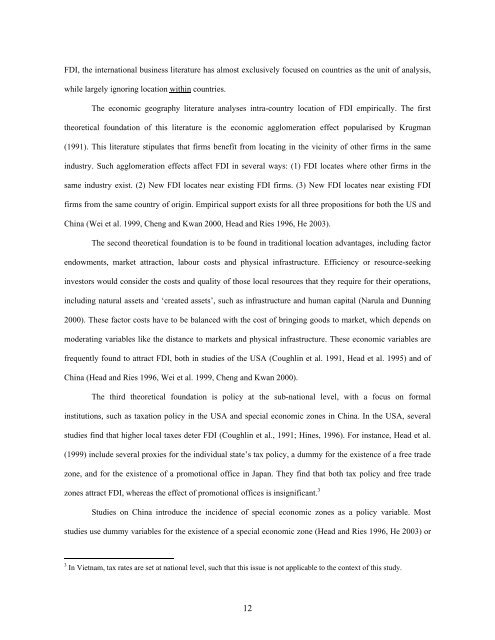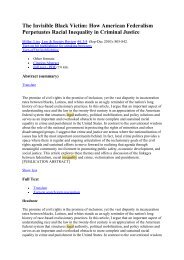Foreign Investment Strategies and Sub-national ... - E-Journal
Foreign Investment Strategies and Sub-national ... - E-Journal
Foreign Investment Strategies and Sub-national ... - E-Journal
Create successful ePaper yourself
Turn your PDF publications into a flip-book with our unique Google optimized e-Paper software.
FDI, the inter<strong>national</strong> business literature has almost exclusively focused on countries as the unit of analysis,<br />
while largely ignoring location within countries.<br />
The economic geography literature analyses intra-country location of FDI empirically. The first<br />
theoretical foundation of this literature is the economic agglomeration effect popularised by Krugman<br />
(1991). This literature stipulates that firms benefit from locating in the vicinity of other firms in the same<br />
industry. Such agglomeration effects affect FDI in several ways: (1) FDI locates where other firms in the<br />
same industry exist. (2) New FDI locates near existing FDI firms. (3) New FDI locates near existing FDI<br />
firms from the same country of origin. Empirical support exists for all three propositions for both the US <strong>and</strong><br />
China (Wei et al. 1999, Cheng <strong>and</strong> Kwan 2000, Head <strong>and</strong> Ries 1996, He 2003).<br />
The second theoretical foundation is to be found in traditional location advantages, including factor<br />
endowments, market attraction, labour costs <strong>and</strong> physical infrastructure. Efficiency or resource-seeking<br />
investors would consider the costs <strong>and</strong> quality of those local resources that they require for their operations,<br />
including natural assets <strong>and</strong> ‘created assets’, such as infrastructure <strong>and</strong> human capital (Narula <strong>and</strong> Dunning<br />
2000). These factor costs have to be balanced with the cost of bringing goods to market, which depends on<br />
moderating variables like the distance to markets <strong>and</strong> physical infrastructure. These economic variables are<br />
frequently found to attract FDI, both in studies of the USA (Coughlin et al. 1991, Head et al. 1995) <strong>and</strong> of<br />
China (Head <strong>and</strong> Ries 1996, Wei et al. 1999, Cheng <strong>and</strong> Kwan 2000).<br />
The third theoretical foundation is policy at the sub-<strong>national</strong> level, with a focus on formal<br />
institutions, such as taxation policy in the USA <strong>and</strong> special economic zones in China. In the USA, several<br />
studies find that higher local taxes deter FDI (Coughlin et al., 1991; Hines, 1996). For instance, Head et al.<br />
(1999) include several proxies for the individual state’s tax policy, a dummy for the existence of a free trade<br />
zone, <strong>and</strong> for the existence of a promotional office in Japan. They find that both tax policy <strong>and</strong> free trade<br />
zones attract FDI, whereas the effect of promotional offices is insignificant. 3<br />
Studies on China introduce the incidence of special economic zones as a policy variable. Most<br />
studies use dummy variables for the existence of a special economic zone (Head <strong>and</strong> Ries 1996, He 2003) or<br />
3 In Vietnam, tax rates are set at <strong>national</strong> level, such that this issue is not applicable to the context of this study.<br />
12














